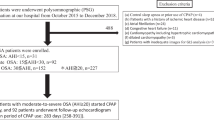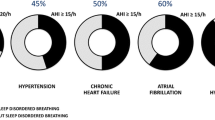Abstract
Obstructive sleep apnea (OSA) syndrome is the most common sleep-breathing disorder, which is associated with increase cardiovascular morbidity and mortality. OSA increases risk of resistant arterial hypertension, coronary artery disease, heart failure, pulmonary hypertension, and stroke. Studies showed the significant relationship between OSA and cardiac remodeling. The majority of investigations were focused on the left ventricle and its hypertrophy and function. Fewer studies investigated right ventricular structure and function revealing deteriorated diastolic and systolic function. Data regarding left and right ventricular mechanics in OSA patients are scarce and controversial. The results of the studies that were focused on the influence of continuous positive airway pressure and weight reduction on cardiac remodeling revealed favorable effect on left and right ventricular structure and function. Recently published analyses confirmed positive effect of treatment on cardiac mechanics. Deterioration of left and right ventricular mechanics occurs before functional and structural cardiac impairments in the cascade of cardiac remodeling and therefore the assessment of left and right ventricular strain may represent a cornerstone in detection of subtle cardiac changes that develop significantly before other, often irreversible, alterations. Considering the fact that left and right ventricular strains have important predictive value in wide range of cardiovascular diseases, one should consider the evaluation of left and right ventricular strains in the routine echocardiographic assessment at all stages of disease—from diagnosis, during follow-up and evaluation of therapeutic effects. The main aim of this review is to provide the current overview of cardiac mechanics in OSA patients before and after (during) therapy, as well as mechanisms that could be responsible for cardiac changes.

Similar content being viewed by others
References
Young T, Palta M, Dempsey J, Skatrud J, Weber S, Badr S (1993) The occurrence of sleep-disordered breathing among middle-aged adults. N Engl J Med 328(17):1230–1235
Bauters FA, Hertegonne KB, De Buyzere ML, Joos GF, Chirinos JA, Rietzschel ER (2019) Phenotype and risk burden of sleep apnea: a population-based cohort study. Hypertension. 74(4):1052–1062
Lee CH, Sethi R, Li R, Ho HH, Hein T, Jim MH, Loo G, Koo CY, Gao XF, Chandra S, Yang XX, Furlan SF, Ge Z, Mundhekar A, Zhang WW, Uchôa CH, Kharwar RB, Chan PF, Chen SL, Chan MY, Richards AM, Tan HC, Ong TH, Roldan G, Tai BC, Drager LF, Zhang JJ (2016) Obstructive sleep apnea and cardiovascular events after percutaneous coronary intervention. Circulation. 133:2008–2017
Wang H, Parker JD, Newton GE, Floras JS, Mak S, Chiu KL, Ruttanaumpawan P, Tomlinson G, Bradley TD (2007) Influence of obstructive sleep apnea on mortality in patients with heart failure. J Am Coll Cardiol 49:1625–1631
Valham F, Mooe T, Rabben T, Stenlund H, Wiklund U, Franklin KA (2008) Increased risk of stroke in patients with coronary artery disease and sleep apnea: a 10-year follow-up. Circulation. 118:955–960
Baguet JP, Nadra M, Barone-Rochette G, Ormezzano O, Pierre H, Pépin JL (2009) Early cardiovascular abnormalities in newly diagnosed obstructive sleep apnea. Vasc Health Risk Manag 5:1063–1073
Baguet JP, Barone-Rochette G, Lévy P, Vautrin E, Pierre H, Ormezzano O, Pépin JL (2010) Left ventricular diastolic dysfunction is linked to severity of obstructive sleep apnoea. Eur Respir J 36(6):1323–1329
Sascău R, Zota IM, Stătescu C, Boișteanu D, Roca M, Maștaleru A, Leon Constantin MM, Vasilcu TF, Gavril RS, Mitu F (2018) Review of echocardiographic findings in patients with obstructive sleep apnea. Can Respir J 2018:1206217
Yu L, Li H, Liu X, Fan J, Zhu Q, Li J, Jiang J, Wang J (2019) Left ventricular remodeling and dysfunction in obstructive sleep apnea: systematic review and meta-analysis. Herz.:1–13. https://doi.org/10.1007/s00059-019-04850-w
Cuspidi C, Tadic M, Sala C, Gherbesi E, Grassi G, Mancia G (2019) Targeting concentric left ventricular hypertrophy in obstructive sleep apnea syndrome a meta-analysis of echocardiographic studies. Am J Hypertens. https://doi.org/10.1093/ajh/hpz198
Fung JW, Li TS, Choy DK, Yip GW, Ko FW, Sanderson JE, Hui DS (2002) Severe obstructive sleep apnea is associated with left ventricular diastolic dysfunction. Chest. 121(2):422–429
Zhou NW, Shu XH, Liu YL, Shen H, Li WJ, Gong X, Chen HY, Zhao WP, Pan CZ, Li SQ (2016) A novel method for sensitive determination of subclinical left-ventricular systolic dysfunction in subjects with obstructive sleep apnea. Respir Care 61(3):366–375
Wang D, Ma GS, Wang XY, Lu QQ, Wang Y, Liu NF (2016) Left ventricular dysfunction associated with myocardial deformation changes in obstructive sleep apnea patients estimated by real-time 3D speckle-tracking echocardiography. Sleep Breath 20(1):135–144
Vitarelli A, D'Orazio S, Caranci F, Capotosto L, Rucos R, Iannucci G, Continanza G, Dettori O, De Cicco V, Vitarelli M, De Maio M, De Chiara S, Saponara M (2013) Left ventricular torsion abnormalities in patients with obstructive sleep apnea syndrome: an early sign of subclinical dysfunction. Int J Cardiol 165(3):512–518
Altekin RE, Karakas MS, Yanikoglu A, Ozel D, Ozbudak O, Demir I, Deger N (2012) Determination of right ventricular dysfunction using the speckle tracking echocardiography method in patients with obstructive sleep apnea. Cardiol J 19(2):130–139
Kepez A, Niksarlioglu EY, Hazirolan T, Ranci O, Kabul HK, Demir AU, Kaya EB, Kocabas U, Aytemir K, Sahin A, Tokgozoglu L, Nazli N (2009) Early myocardial functional alterations in patients with obstructive sleep apnea syndrome. Echocardiography. 26(4):388–396
Li J, Wang Z, Li Y, Meng Y, Li R, Wang W, Fu X (2016) Assessment of regional right ventricular systolic function in patients with obstructive sleep apnea syndrome using velocity vector imaging. Medicine (Baltimore) 95(37):e4788
Hammerstingl C, Schueler R, Wiesen M, Momcilovic D, Pabst S, Nickenig G, Skowasch D (2012) Effects of untreated obstructive sleep apnea on left and right ventricular myocardial function. Int J Cardiol 155(3):465–469
Tugcu A, Yildirimtürk O, Tayyareci Y, Demiroglu C, Aytekin S (2010) Evaluation of subclinical right ventricular dysfunction in obstructive sleep apnea patients using velocity vector imaging. Circ J 74(2):312–319
Holtstrand Hjälm H, Fu M, Hansson PO, Zhong Y, Caidahl K, Mandalenakis Z, Morales D, Ergatoudes C, Rosengren A, Grote L, Thunström E (2018) Association between left atrial enlargement and obstructive sleep apnea in a general population of 71-year-old men. J Sleep Res 27(2):252–258
Kim SM, Cho KI, Kwon JH, Lee HG, Kim TI (2012) Impact of obstructive sleep apnea on left atrial functional and structural remodeling beyond obesity. J Cardiol 60(6):475–483
Çetin S, Vural M, Akdemir R, Fırat H (2018) Left atrial remodelling may predict exercise capacity in obstructive sleep apnoea patients. Acta Cardiol 73(5):471–478
Drager LF, McEvoy RD, Barbe F, Lorenzi-Filho G, Redline S, INCOSACT Initiative (International Collaboration of Sleep Apnea Cardiovascular Trialists) (2017) Sleep apnea and cardiovascular disease: lessons from recent trials and need for team science. Circulation. 136(19):1840–1850
Javaheri S, Barbe F, Campos-Rodriguez F, Dempsey JA, Khayat R, Javaheri S, Malhotra A, Martinez-Garcia MA, Mehra R, Pack AI, Polotsky VY, Redline S, Somers VK (2017) Sleep apnea: types, mechanisms, and clinical cardiovascular consequences. J Am Coll Cardiol 69(7):841–858
Bradley TD, Floras JS (2003) Sleep apnea and heart failure: part II: central sleep apnea. Circulation 107:1822–1826
Jean-Louis G, Zizi F, Brown D, Ogedegbe G, Borer J, McFarlane S (2009) Obstructive sleep apnea and cardiovascular disease: evidence and underlying mechanisms. Minerva Pneumol 48:277–293
Altekin RE, Yanikoglu A, Baktir AO, Karakas MS, Ozel D, Cilli A, Yildirim AB, Yilmaz H, Yalcinkaya S (2012) Assessment of subclinical left ventricular dysfunction in obstructive sleep apnea patients with speckle tracking echocardiography. Int J Cardiovasc Imaging 28(8):1917–1930
Opdahl A, Helle-Valle T, Skulstad H, Smiseth OA (2015) Strain, strain rate, torsion, and twist: echocardiographic evaluation. Curr Cardiol Rep 17(3):568
Sareen N, Ananthasubramaniam K (2016) Strain imaging: from physiology to practical applications in daily practice. Cardiol Rev 24(2):56–69
Buckberg G, Hoffman JI, Mahajan A, Saleh S, Coghlan C (2008) Cardiac mechanics revisited: the relationship of cardiac architecture to ventricular function. Circulation. 118(24):2571–2587
Sallin EA (1969) Fiber orientation and ejection fraction in the human left ventricle. Biophys J 9:954–964
Varghese MJ, Sharma G, Shukla G, Seth S, Mishra S, Gupta A, Bahl VK (2017) Longitudinal ventricular systolic dysfunction in patients with very severe obstructive sleep apnea: a case control study using speckle tracking imaging. Indian Heart J 69(3):305–310
Cho KI, Kwon JH, Kim SM, Park TJ, Lee HG, Kim TI (2012) Impact of obstructive sleep apnea on the global myocardial performance beyond obesity. Echocardiography. 29(9):1071–1080
Dobrowolski P, Klisiewicz A, Florczak E, Prejbisz A, Bieleń P, Sliwiński P, Kabat M, Rybicka J, Topór-Mądry R, Januszewicz A, Hoffman P (2014) Independent association of obstructive sleep apnea with left ventricular geometry and systolic function in resistant hypertension: the RESIST-POL study. Sleep Med 15(11):1302–1308
Vural MG, Çetin S, Keser N, Firat H, Akdemir R, Gunduz H (2017) Left ventricular torsion in patients with obstructive sleep apnoea before and after continuous airway pressure therapy: assessment by two-dimensional speckle tracking echocardiography. Acta Cardiol 72(6):638–647
D'Andrea A, Martone F, Liccardo B, Mazza M, Annunziata A, Di Palma E, Conte M, Sirignano C, D'Alto M, Esposito N, Fiorentino G, Russo MG, Bossone E, Calabrò R (2016) Acute and chronic effects of noninvasive ventilation on left and right myocardial function in patients with obstructive sleep apnea syndrome: a speckle tracking echocardiographic study. Echocardiography. 33(8):1144–1155
Güvenç TS, Hüseyinoğlu N, Özben S, Kul Ş, Çetin R, Özen K, Doğan C, Balci B (2016) Right ventricular geometry and mechanics in patients with obstructive sleep apnea living at high altitude. Sleep Breath 20(1):5–13
Vitarelli A, Terzano C, Saponara M, Gaudio C, Mangieri E, Capotosto L, Pergolini M, D’Orazio S, Continanza G, Cimino E (2015) Assessment of right ventricular function in obstructive sleep apnea syndrome and effects of continues positive airway syndrome and effects of continuous positive airway pressure therapy: a pilot study. Can J Cardiol 31(7):823–831
Sun Y, Yuan H, Zhao MQ, Wang Y, Xia M, Li YZ (2014) Cardiac structural and functional changes in old elderly patients with obstructive sleep apnoea–hypopnea syndrome. J Int Med Res 42(2):395–404
Dursunoglu N, Dursunoglu D, Kilic M (2005) Impact of obstructive sleep apnea on right ventricular global function: sleep apnea and myocardial performance index. Respiration 72:278–284
Varol E, Akcay S (2010) Ozaydin et al. Influence of obstructive sleep apnea on left ventricular mass and global function: sleep apnea and myocardial performance index. Heart Vessel 25(5):400–404
Arias MA, Garcia-Ri F, Alonso-Fernandez A et al (2005) Obstructive sleep apnea syndrome affects left ventricular diastolic function. Circulation 112(3):375–383
Buckberg GD, Hoffman JI, Coghlan HC, Nanda NC (2015) Ventricular structure-function relations in health and disease: part I. The normal heart. Eur J Cardiothorac Surg 47(4):587–601
Tadic M (2015) Multimodality evaluation of the right ventricle: an updated review. Clin Cardiol 38(12):770–776
Hammerstingl C, Schueler R, Wiesen M, Momcilovic D, Pabst S, Nickenig G, Skowasch D (2013) Impact of untreated obstructive sleep apnea on left and right ventricular myocardial function and effects of CPAP therapy. PLoS One 8(10):e76352
Buonauro A, Galderisi M, Santoro C, Canora A, Bocchino ML, Lo Iudice F, Lembo M, Esposito R, Castaldo S, Trimarco B, Sanduzzi A (2017) Obstructive sleep apnea and right ventricular function: a combined assessment by speckle tracking and three-dimensional echocardiography. Int J Cardiol 243:544–549
Kim D, Shim CY, Cho YJ, Park S, Lee CJ, Park JH, Cho HJ, Ha JW, Hong GR (2019) Continuous positive airway pressure therapy restores cardiac mechanical function in patients with severe obstructive sleep apnea: a randomized, sham-controlled study. J Am Soc Echocardiogr 32(7):826–835
Author information
Authors and Affiliations
Corresponding author
Ethics declarations
Conflict of interest
No conflict of interest was reported.
Additional information
Publisher’s note
Springer Nature remains neutral with regard to jurisdictional claims in published maps and institutional affiliations.
Rights and permissions
About this article
Cite this article
Tadic, M., Cuspidi, C., Grassi, G. et al. Obstructive sleep apnea and cardiac mechanics: how strain could help us?. Heart Fail Rev 26, 937–945 (2021). https://doi.org/10.1007/s10741-020-09924-0
Published:
Issue Date:
DOI: https://doi.org/10.1007/s10741-020-09924-0




